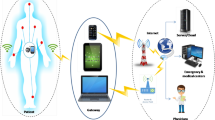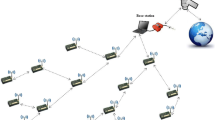Abstract
Data aggregation is considered as one of the fundamental distributed data processing procedures for saving the energy and minimizing the medium access layer contention in wireless sensor networks. However, sensor networks are likely to be deployed in an untrusted environment, which make them vulnerable against several attacks. A compromised node may forge arbitrary aggregation value and mislead the base station into trusting a false reading. Secure in-network aggregation can detect such manipulation. But, as long as such subversive activity is, reliable aggregation result can not be obtained. In contrast, the collection of individual sensor node values is robust and solves the problem of availability, but in an inefficient way. Our work seeks to bridge this gap in secure data collection. We propose a framework that enhances availability with efficiency close to that of in-network aggregation avoiding over-reliance on sensors. To achieve this, we design a scheme that is built on one core concept: no trust is supposed in any sensor. Therefore, we design a two hierarchical levels of monitoring to ensure the integrity and the accuracy of aggregate result, only when necessary, i.e. only when malicious activities are detected. Relying on this new type of monitoring mechanism, the framework has the ability to recover from aggregator failure without neglecting energy efficiency, providing thus much higher availability than other security protocols.













Similar content being viewed by others
References
Mármol, F. G., & Pérez, G. M. (2011). Providing trust in wireless sensor networks using a bio-inspired technique. Telecommunications Systems, 46(2), 163–180.
Ye, Z., Abouzeid, A. A., & Jing Ai, J. (2007). Optimal policies for distributed data aggregation in wireless sensor networks. In 26th IEEE international conference on computer communications, May 2007 (pp. 1676–1684).
Krishnamachari, B., Estrin, D., & Wicker, S. (2002). The impact of data aggregation in wireless sensor networks. In 22nd international conference on distributed computing systems (pp. 575–578).
Madden, S., Franklin, M. J., & Hellerstein, J. M. (2002). TAG: a tiny aggregation service for ad-hoc sensor networks. In 5th symposium on operating systems design and implementation, December 2002 (pp. 131–146).
Itanagonwiwat, C., Govindan, R., & Estrin, D. (2000). Directed diffusion: a scalable and robust communication paradigm for sensor networks (Technical report 00-732). University of Southern California.
Deshpande, A., Nath, S., Gibbons, P. B., & Seshan, S. (2003). Cache-and-query for wide area sensor databases. In 2003 ACM SIGMOD international conference on management of data (pp. 503–514).
Solis, I., & Obraczka, K. (2004). The impact of timing in data aggregation for sensor networks. In IEEE international conference on communications, June 2004 (pp. 3640–3646).
Tang, X., & Xu, J. (2006). Extending network lifetime for precision constrained data aggregation in wireless sensor networks. In 25th IEEE international conference on computer communications, April 2006 (pp. 1–6).
Fasolo, E., Rossi, M., Widmer, J., & Zorzi, M. (2007). In-network aggregation techniques for wireless sensor networks: a survey. IEEE Wireless Communications, 14(2), 70–87.
Rajagopalan, R., & Varshney, P. K. (2006). Data-aggregation techniques in sensor networks: a survey. IEEE Communications Surveys and Tutorials, 8(4), 48–63.
Akyildiz, I. F., Su, W., Sankarasubramaniam, Y., & Cayirci, E. (2002). A survey on sensor networks. IEEE Communications Magazine, 40(8), 102–114.
Ganeriwal, S., & Srivastava, M. (2004). Reputation-based framework for high integrity sensor networks. In 2nd ACM workshop on security of ad hoc and sensor networks, October 2004 (pp. 66–77).
Ning, P., & Sun, K. (2005). How to misuse AODV: a case study of insider attacks against mobile ad-hoc routing protocols. Ad Hoc Networks, 3(6), 795–819.
Perrig, A., Stankovic, J., & Wagner, D. (2004). Security in wireless sensor networks. In Communication of the ACM.
Labraoui, N., Guerroui, M., Aliouat, M., & Zia, T. (2011). Data aggregation security challenge in wireless sensor networks: a survey. Ad hoc & Sensor Networks, International Journal, 12(3–4), 295–324.
Bagaa, M., Lasla, N., Ouadjaout, A., & Challal, Y. (2007). SEDAN: secure and efficient protocol for data aggregation in wireless sensor networks. In 32nd IEEE conference on local computer networks, October 2007 (pp. 1053–1060).
Hu, L., & Evans, D. (2003). Secure aggregation for wireless networks. In Symposium on applications and the internet workshops, January 2003 (pp. 384–391).
Przydatek, B., Song, D., & Perrig, A. (2003). SIA: secure information aggregation in sensor networks. In 1st ACM international conference on embedded networked sensor systems (pp. 255–265).
Du, W., Deng, J., Han, Y. S., & Varshney, P. (2003). A witness-based approach for data fusion assurance in wireless sensor networks. In Global telecommunication conference (Vol. 3, pp. 1435–1439).
Yang, Y., Wang, X., Zhu, S., & Cao, G. (2006). SDAP: a secure hop-by-hop data aggregation protocol for sensor networks. In 7th ACM international symposium on mobile ad hoc networking and computing (pp. 356–367).
Cristofaro, E., Bohli, M. J., & Westhoff, D. (2009). FAIR: fuzzy-based aggregation providing in-network resilience for real-time wireless sensor networks. In 2nd ACM conference on wireless network security (pp. 253–260).
Jaydip, S. (2011). A robust and secure aggregation protocol for wireless sensor networks. In 6th international symposium on electronic design, test and applications, January 2011 (pp. 222–227).
Boulis, A., Ganeriwal, S., & Srivastava, M. B. (2003). Aggregation in sensor networks: an energy-accuracy trade-off. Ad Hoc Networks, 1(2), 317–331.
Sun, K., Peng, P., Ning, P., & Wang, C. (2006). Secure distributed cluster formation in wireless sensor networks. In 22nd annual computer security applications conference, December 2006 (pp. 131–140).
Ergen, S. C., & Varaiya, P. (2010). TDMA scheduling algorithms for wireless sensor networks. Wireless Networks, 4, 985–997.
Wagner, D. (2004). Resilient aggregation in sensor networks. In 2nd ACM workshop on security of ad hoc and sensor networks (pp. 78–87).
Kumar, A., & Ribeiro, V. J. (2009). REEF: a reliable and energy efficient framework for wireless sensor networks. In 1st international communication systems and networks and workshops, January 2009 (pp. 1–9).
Can, H., Perrig, A., & Song, D. (2006). Secure hierarchical in-network aggregation in sensor networks. In 13th ACM conference on computer and communications security (pp. 278–287).
Handy, M., Haase, M., & Timmermann, D. (2002). Low energy adaptive clustering hierarchy with deterministic cluster-head selection. In 4th international workshop on mobile and wireless communications networks (p. 368).
Manjeshwar, A., & Agrawal, D. (2002). TEEN: a protocol for enhanced efficiency in WSN. In IEEE international symposium on parallel and distributed processing (pp. 2009–2015).
Manjeshwar, A., & Agrawal, D. (2002). APTEEN: a hybrid protocol for efficient routing and a comprehensive information retrieval in WSN. In IEEE international symposium on parallel and distributed processing (pp. 195–202).
Perrig, A., Szewczyk, R., Wen, V., Cullar, D., & Tygar, J.D. (2001). Spins: security protocols for sensor networks. In 7th annual ACM/IEEE international conference on mobile computing and networking (pp. 189–199).
Karlof, C., Sastry, N., & Wagner, D. (2004). TinySec: a link layer security architecture for wireless sensor networks. In 2nd international conference on embedded networked sensor systems (pp. 162–175).
Wander, A. S., Gura, N., Eberle, H., Gupta, V., & Shantz, S. (2005). Energy analysis of public-key cryptography on small wireless devices. In 3rd IEEE international conference on pervasive computing, March 2005.
Wu, K., Dreef, D., Sun, B., & Xiao, Y. (2006). Secure data aggregation without persistent cryptographic operations in wireless sensor networks. In 21st IEEE international conference on performance computing and communications (p. 85).
Li, H., Chan, E., & Chen, G. (2010). AEETC—adaptive energy-efficient timing control in wireless networks with network coding. Telecommunications Systems, 45(4), 289–301.
Dargie, W., Xiaojuan, C., & Denko, M. K. (2010). Modelling the energy cost of a fully operational wireless sensor network. Telecommunications Systems, 44(1–2), 3–15.
Cheng, S. T., & Wu, M. (2009). Optimization of multilevel power adjustment in wireless sensor networks. Telecommunications Systems, 42(1–2), 109–121.
Author information
Authors and Affiliations
Corresponding author
Rights and permissions
About this article
Cite this article
Labraoui, N., Gueroui, M., Aliouat, M. et al. Reactive and adaptive monitoring to secure aggregation in wireless sensor networks. Telecommun Syst 54, 3–17 (2013). https://doi.org/10.1007/s11235-013-9712-3
Published:
Issue Date:
DOI: https://doi.org/10.1007/s11235-013-9712-3




